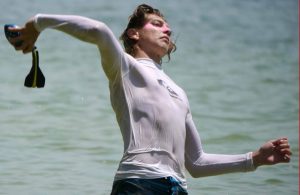Understanding the biomechanics of Shoulder Pain in the overhead athlete

Do you experience pain on overhead activities? Do you wonder what the underlying cause is?
The shoulder, being the most mobile joint of the human body, is highly susceptible to injury. Athletes often incur injuries of the shoulder as they subject the joint to extreme ranges of motion and force, as well as excessive repetitions of these motions
Overhead athletes (baseball, softball, cricket, tennis, basketball and swimmers) are particularly susceptible to injury of the shoulder. Pain experienced in the shoulder may be related to instability of the shoulder, There are two types of stabilisers of the shoulder:- static and dynamic. The static stabilisers are the ligaments and labrum or cartilage of the shoulder socket and the dynamic stabilizers are the rotator cuff muscles.
What happens in the Cocking Phase?
The arm is in an elevated abducted and externally rotated position. The muscles involved are the posterior deltoid, infraspinatus and teres minor. There is a risk of overactivity of the infraspinatus muscle and the head of the humerus pushing forward in the capsule.
What happens in the Acceleration Phase?
The acceleration phase is the main propulsive phase when the arm moves forward and injury during this phase is seen in throwing and racquet sports. The main muscles involved here are the anterior deltoid, pectoralis major, teres major, subscapularis and latissimus dorsi muscles. Repetitive movement in this phase can result in tendinopathy of the supraspinatus and biceps tendons. Athletes may also present with stress fractures of the coracoid process or humerus, and glenoid labral tears as result of overuse of the shoulder.
What happens in the Follow through Phase?
During this phase the posterior capsule is under stress and symptoms occur from this region. The infraspinatus provides restraint in this phase.
The most common injuries that occurs in the overhead athlete is shoulder instability, rotator cuff pathology and superior labral tears. Contracture of the posterior capsule and laxity of the anterior capsule is often one of the causes of shoulder instability in the overhead athlete.
Put Simply
For a strong throwing shoulder and less risk of injury, it is all about the correct sequencing of certain muscle contractions and a perfect balance between tightness and weakness. As discussed above, the static stabilising muscles need to be able to support the shoulder blade adequately before the larger dynamic muscles do their job. Throwing using a shoulder that has poor scapular stability is the same as a large Construction Crane extending it’s reach over a house fully loaded, with no support struts at the base of the vehicle. Eventually it topples over. In shoulders, something ends up failing, usually the tendons or their insertion points.
What next?
Come visit us at MGS Physiotherapy for an assessment and guidance. The key is working out where the imbalance lies and addressing the function. This explains why some people may get temporary relief from cortisone injections, anti inflammatory medications and rest, but the symptoms often recur once that person gets back into their activities.
